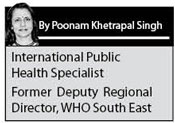Reply To:
Name - Reply Comment
Last Updated : 2024-04-20 11:47:00
 It is important to take note of these achievements as well as residual and new challenges. This is crucial because Sri Lanka is at a transition stage. Its demographic, epidemiological and public health demands are evolving. That aside, after 30 years of conflict, it is beginning to rebuild its economy and looking towards a sustained peace dividend. Inevitably, this will lead to changes that would have implications for its health sector as well.
It is important to take note of these achievements as well as residual and new challenges. This is crucial because Sri Lanka is at a transition stage. Its demographic, epidemiological and public health demands are evolving. That aside, after 30 years of conflict, it is beginning to rebuild its economy and looking towards a sustained peace dividend. Inevitably, this will lead to changes that would have implications for its health sector as well..jpg) For a start, there is the accelerated rise of the private sector as a health-care provider. While public/government spending on health is a strong 1.7 per cent of GDP (as we saw earlier), it is matched and even bettered by private sector spending (1.8 per cent of GDP). Gradually a pattern is emerging. The public sector appears to dominate inpatient provision (over 90 per cent). The outpatient burden is seeing an expanding role for the private sector, concentrated in urban areas.
For a start, there is the accelerated rise of the private sector as a health-care provider. While public/government spending on health is a strong 1.7 per cent of GDP (as we saw earlier), it is matched and even bettered by private sector spending (1.8 per cent of GDP). Gradually a pattern is emerging. The public sector appears to dominate inpatient provision (over 90 per cent). The outpatient burden is seeing an expanding role for the private sector, concentrated in urban areas.
Add comment
Comments will be edited (grammar, spelling and slang) and authorized at the discretion of Daily Mirror online. The website also has the right not to publish selected comments.
Reply To:
Name - Reply Comment
On March 26, a couple arriving from Thailand was arrested with 88 live animal
According to villagers from Naula-Moragolla out of 105 families 80 can afford
Is the situation in Sri Lanka so grim that locals harbour hope that they coul
A recent post on social media revealed that three purple-faced langurs near t